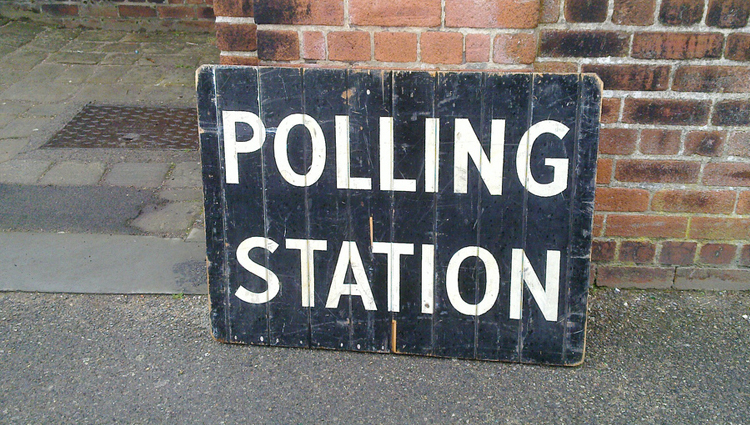There's No Queue in E-L-E-C-T-I-O-N: The Logistics of an Election

(Inside Science) -- When voters arrive at the polls, they typically are thinking about their candidate, not the mathematical models and systems that may be making that vote possible. Managing the logistics of an election – from delivering voting machines to the right locations at the right time to ensuring that lines don't grow too long – requires complex mathematical models, according to presentations delivered earlier this month at the annual meeting of The Institute for Operations Research and the Management Sciences (INFORMS) in Washington, DC.
Although federal and state laws govern elections, many issues – everything from the type of voting machine to be used to which issues appear on the ballot – are determined at the local level. In order to avoid the punch card ballot problems that plagued Florida in the 2000 presidential election, many locations moved to computerized touch-screen voting machines (also called direct-recording electronic voting machines) for 2004. While that solved some issues related to voting machines, it created new ones. The length of the ballot has proved to be a big concern because in precincts with a lot of candidates and issues on the ballot voters tend to take considerable time to navigate through their digital ballots, slowing the process and creating long lines.
In the aftermath of the 2004 election, some Franklin County, Ohio, officials were concerned about the efficiency of voting at different precincts in the county. Some people waited seven hours to vote, while voters at other precincts had no wait at all. The problem stemmed in part from an inability to predict the where the number of voters was going to be high or where, because of the number of issues on a ballot, voting was going to take more time.
County election officials contacted Theodore Allen, an Ohio State University integrated systems engineer, to develop a way to avoid this disparity in the waiting time at different precincts in future elections. Allen approached the problem from the viewpoint of queuing theory, which is concerned with the mathematical analysis of the lines in which people, computers, airliners, or other objects must wait for their turn.
Allen’s goal was to make lines shorter and ensure that the delay in voting caused by long lines would not discriminate against any particular demographic. Because of the way machines were allocated in 2004, locations with longer ballots did not receive enough extra machines to keep lines flowing.
Most of the precincts affected were in areas with large African American populations, which meant that the average African-American voter waited 30 minutes more than voters who were white or of another ethnicity, Allen found. The county has a set number of voting machines available, but the solution to making the lines, and thus the voting time, the same in all the precincts turned on how the machines are distributed in the hundreds of individual voting locations. To find the solution, Allen built queuing models to show how lines would grow longer, based on different ways of distributing the machines.
Allen said that the basic components of the problem are simple. "You can pretty much nail everything you need. "Not only can you model the number of people arriving to vote on the machines, but you can model how long it takes to vote, and the expected breakdowns of the machines. “So you pretty much get direct information to predict the lines in advance with reasonable accuracy," he said.
The models essentially reflect a common-sense explanation of how lines develop. Lines grow when voters come to the polls at a faster rate than they are served. Problems also build when a few people take longer to vote than is expected or when people arrive in bunches rather than smoothly throughout the day. The reason that the lines in some precincts were so long in 2004 was that the amount of time it actually took to vote once a person was in the voting booth was not considered. This year he anticipates that it will take people in some precincts twice as long to vote as others based merely on the length of the ballot.
Allen's analysis should make a big difference for voters in Franklin County on Election Day. "If we weren't on the scene there would be several precincts that would be very overmatched," Allen said. "They would almost certainly have lines. And the lines generally would be considerably longer."
This is not to say that there will be no lines. There are only so many voting machines to go around. Ohio allows voters to obtain ballots and vote early, removing some of the burden from the precincts, but Allen's simulations still show that six locations in Franklin County, which includes the city of Columbus, are likely to experience three hour waits on Election Day, despite the addition of 2,000 machines.
This year more than fifty percent of American voters will be voting with paper ballots that will be counted by optical scan machines, according to one of the voting machine manufacturers. Voting with an optical scanner is similar to taking a multiple-choice test. Darken the circles corresponding to your preferred candidates, then take your ballot to a central machine to be scanned and recorded. The machines are efficient and create a paper record of the votes, but they present an entirely different problem to election officials.
These machines are so large that poll workers cannot pick them up from a central location and transport them in passenger cars. They must be delivered to precincts by truck, which presents a set of logistical challenges and actually ties the efficient election problem to efficient distribution problems that are typically of interest only to delivery services and manufacturers.
Not long before a primary election in May of 2006, a trucking company from the Cincinnati area contacted with Michael Fry, a professor of Operations Management at the University of Cincinnati, with an urgent request for help. They had been tasked with distributing hundreds of voting machines to 531 different locations around the county (Hamilton). It was a big job that was made more difficult because handling voting machines involved a special set of restrictions.
Until the machines could be delivered, they had to be kept in a secure location. Arranging delivery at precincts located in community centers and schools which could only take deliveries at certain times proved a challenge, as did coordinating deliveries with poll officials so the machines could be placed in the correct room within the building. Furthermore, most of the workers wanted to receive the machines on the Friday or Monday directly before the election, which created a crunch on those days and left little time should delays arise. While election officials were worrying about getting the machines in the right places at the right time, trucking company managers were trying to figure out how to coordinate the more than 500 deliveries involved using the fewest trucks and least amount of fuel.
Fry, working with a colleague, was already developing software to solve a similar problem -- the pickup and delivery of automotive parts to a Toyota factory. In the modeling world this is known as the “vehicle routing problem with time windows" said Fry. Solving it is known to be exceptionally difficult, but finding a workable answer is possible by writing a computer program comparing the massive number of possible sequences and routes.
They adapted the program to substitute voting machines for car parts, and replace the parts factories with voting locations.
Fry’s team designed delivery routes that worked, and all the voting machines reached the precincts in time for the election. The researchers' solution saved the trucking company time, told them how many trucks were required, and minimized the number of miles that were driven.
Fry has not been directly involved in organizing deliveries for the 2008 elections, but remains interested in election issues and plans to pursue more research in the area. "I really think we can do a better job with forecasting the turnout than we are right now," said Fry.
Some analysts look at the unexpectedly large number of people who have voted early and say that it suggests a much larger turnout than in past presidential elections. Ohio State’s Allen remarked that despite a massive increase in the amount of early voters, lines could still grow very large in Franklin County. "Of the remaining people, if over 50 percent votes on Election Day, we are expecting considerable lines. Even with 45 percent of the remaining people voting there will be some lines in excess of two hours."
Any modeling system that offers the opportunity to reallocate machines between precincts because of the expected turnout would have to be approached very carefully because of the potential for abuse, election officials have said. But they hope the work by Allen, Fry and others experts in systems modeling can make Election Day run smoother and ensure that everyone gets to vote.

